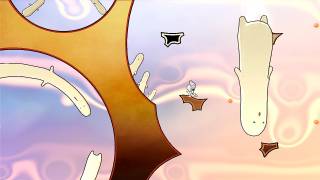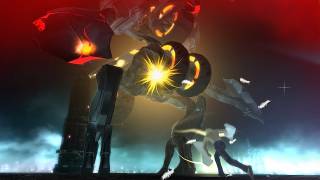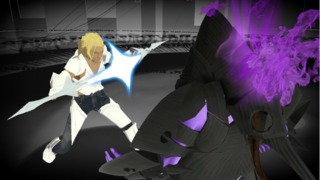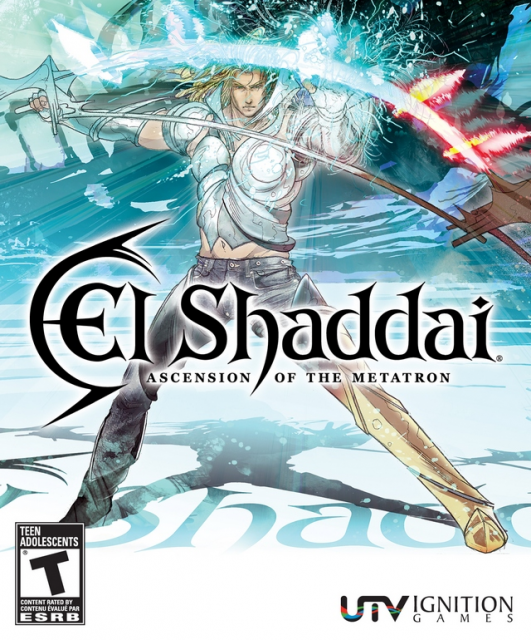An incomprehensible experience like no other.
It is very difficult to find the proper words to describe El Shaddai: Ascension of the Metatron in an accurate manner. The game could best be described as a Devil May Cry-esque action game, but that is only part of what makes the game so unique (at least given its competition). What makes the game truly memorable is the various types of insanity on display. There is little to no cohesion between scenarios, and the game somehow manages to defy expectations and logic on an almost regular basis. Yet somehow, this display of madness synthesizes into a highly gratifying experience unlike anything seen this year, or perhaps this console generation.
Holding the experience together is a religiously motivated story, which performs its job competently enough. The story concerns itself with angellic warrior Enoch and his God-given quest to reign in a group of Fallen Angels. These Fallen Angels have created a type of Heaven-on-Earth for those willing to share in the love that God does not approve. Such a statement makes two things clear about El Shaddai: first, it is a heavily religious game. In fact, the multicultural warning at the beginning of the game merely hints at the religious imagery on display in the game. The writers at UTV Ignition managed to compile as many references to the Bible as possible into this game. Both villains and unseen mentors draw influence from Biblical figures (Ezekial, Raphael, Uriel, etc.) and the game offers its own interpretation of Biblical concepts in great detail ( Nephilim are the most prevalent example). Yet the greater focus is on the theme of love in its various forms. After all, the Fallen Angels created their utopia out of love of humans, something they are not afraid to profess. It is El Shaddai’s job to inform the player as to why God does not approve of this love. It is interesting, then, that, to a certain extent, El Shaddai portrays God and his allies as against love in general. Ignoring the religious issues at hand, much of the actions on behalf of God come across as insensitive and unfeeling. This becomes especially apparent at the beginning of chapter 8, when Lucifel (God’s messenger, unrelated to Lucifer) insults a Fallen Angel while he experiences genuine grief.

Certainly, one of the greatest contributors to this incredibly unique feel is the art style, which, much like the aforementioned scenarios, offers a type of experience unlike anything before it. The game uses every known art style throughout: it begins with cel-shading reminiscent of Catherine, but moves into playing with many different filters. On display are environments with high contrast lighting, outlined objects, pleasing blending of colors, experimenting with shapes, and even some areas that come off as conventional and normal, in comparison. (Obviously, this is not all at once.) It is hard to ignore that El Shaddai looks great. Even on a technical level, it looks amazing; every aspect of the game is smooth and refined, from the models and textures to the animations. Better yet, not once is there a moment of slowdown, making it easier to appreciate all the visual oddities on display, especially with the lack of an intrusive HUD of any type.

In fact, one of the greatest parts of the combat is how balanced and smartly challenging it is. While it is possible to get through many fights with button mashing, it is not at all a good idea; doing so will lead to many deaths, and victory will most likely be a matter of luck. Instead, proper timing of blocks and counterattacks is required to win many of the game’s battles. Nowhere is this more evident than in battles against the Tower’s Watchers. While they certainly draw from a limited pool of attacks, it is hard to pin them to any patterns. Instead, defeating them requires quick timing to give yourself enough time to dodge and attack them after they have attacked. While other boss battles fall into the more traditional pattern-reading model, they still require a decent amount of skill to defeat.

That is not to say that the entire game is easy. However, it would be inaccurate to describe El Shaddai as especially difficult, either. More accurately, progress through the game is, much like the rest of it, very confusing. Battles against the Tower’s Watchers often spring up unexpectedly, and disappear as soon as they came. Despite what the game may suggest, this seems to have nothing to do with prowess in that battle; you will just as quickly exit a battle that would have been victorious as you will one that would end in resounding defeat. After these battles come platforming levels which the game has insinuated are optional, in a sense, making it not only hard to tell if such sections are necessary, but even if it is possible to exit them. The (oddly meaty, given recent trends) manual offers no help, instead listing off features that do not entirely seem to be in the game. For example, it goes into detail about a grading system that is only unlocked after the first playthrough, and explains a use for the orange orbs scattered about the game that is not immediately obvious. Worse yet, El Shaddai is an incredibly short game; achievement hunting aside, the game is only twelve chapters long, all completable in about seven hours (according to Lucifel) spread over two or three days.
Despite this, El Shaddai: Ascension of the Metatron is still an amazing game. Much of the game is unlike anything before it, displaying all types of creative and gratifying art and gameplay styles. Yet what parts that can be traced to other games do not detract from the game; far from it, these portions are, for the most part, very well executed and just as enjoyable as the more visceral portions. Sadly, it looks as though this game is being passed up in favor of other releases, making it even more necessary to recommend this unique experience.
